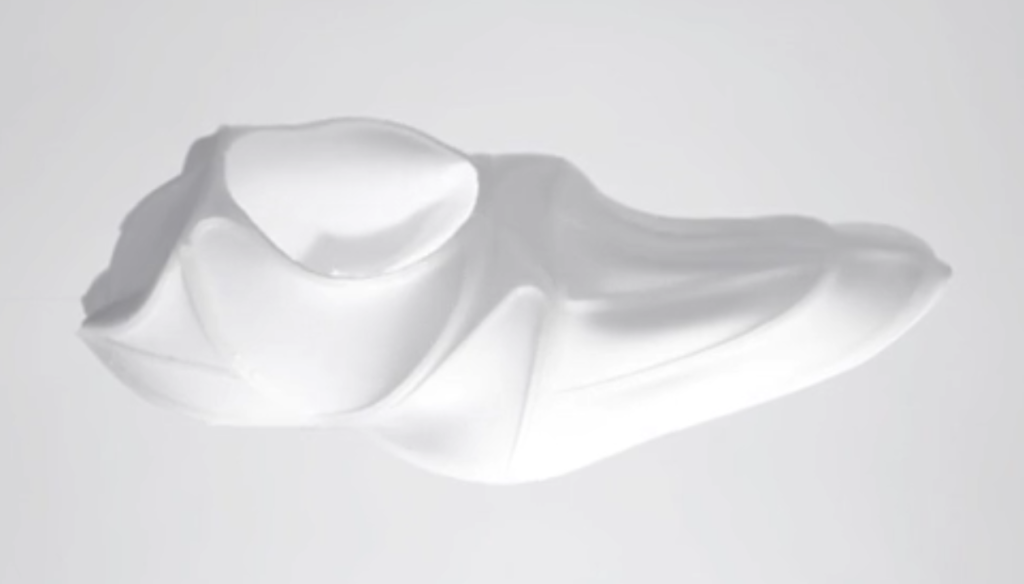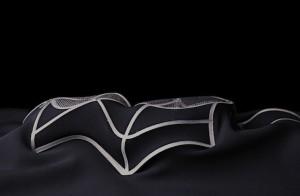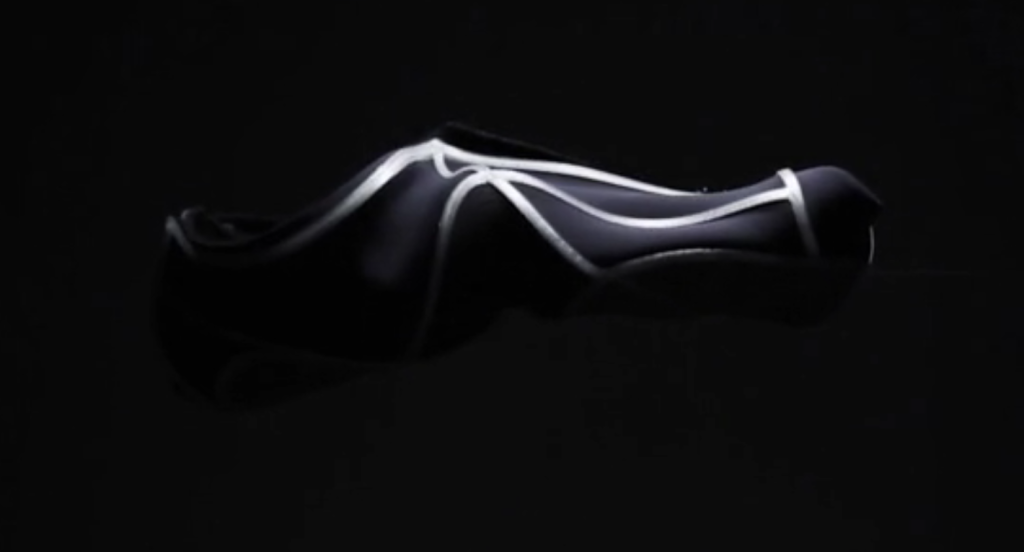
Guberan and Clopath worked closely with Tibbits at MIT while working on programmable materials that would alter their shape based on a specific set of outside stimulation. Their previous work together on jumping textiles specifically led the pair to enlist Tibbits after they were invited to participate in Camper’s Life On Foot exhibition at Design London Museum, where they were to design futuristic footwear. They worked together to develop a 3D printing process that would create “active shoes” capable of being made in a single process and then assembling themselves.
“[Minimal Shoe] is an active textile and it’s a work in progress. We can shrink the size of the shoe, have it contract around your feet. 3D printing [entire] shoes is quite long and inefficient, so we minimized the amount of 3D printing used. It’s quite interesting to say that we don’t have to 3D print the entire shoe, but we can add to existing material,” Guberan explained to The Creators Project.
 The result of their project, the Minimal Shoe, is made by 3D printing extruded plastic onto a heavily stretched piece of textile in a programmable pattern. When stretched, textiles are pulled apart in order to elongate the individual threads in the fabric, when the plastic is printed onto the textile it holds those specific stretched threads in place. Once the stretched textile is released, it will quickly morph into a secondary shape because the 3D printed portions remain the same, while the rest of the material pulls itself back together. Guberan, Clopath and Tibbits simply needed to design the correct pattern and a wearable shoe would assemble itself automatically.
The result of their project, the Minimal Shoe, is made by 3D printing extruded plastic onto a heavily stretched piece of textile in a programmable pattern. When stretched, textiles are pulled apart in order to elongate the individual threads in the fabric, when the plastic is printed onto the textile it holds those specific stretched threads in place. Once the stretched textile is released, it will quickly morph into a secondary shape because the 3D printed portions remain the same, while the rest of the material pulls itself back together. Guberan, Clopath and Tibbits simply needed to design the correct pattern and a wearable shoe would assemble itself automatically.
 Shoes are a lot more complex than most people tend to notice. They typically require a mix of materials, fabrication processes and manual labor to assemble. Guberan, Clopath and Tibbits’ goal was to develop a shape-shifting shoe that can be assembled without any of the standard complexity of modern shoes. The hybrid fabrication technique that they developed allows for total customization, however it is still a work in progress and the trio is still trying to figure out exactly what to do with it. Currently they are considering two options, a process to print the entire shoe, or a process to simply print the top of the shoe and then combine it with standard materials.
Shoes are a lot more complex than most people tend to notice. They typically require a mix of materials, fabrication processes and manual labor to assemble. Guberan, Clopath and Tibbits’ goal was to develop a shape-shifting shoe that can be assembled without any of the standard complexity of modern shoes. The hybrid fabrication technique that they developed allows for total customization, however it is still a work in progress and the trio is still trying to figure out exactly what to do with it. Currently they are considering two options, a process to print the entire shoe, or a process to simply print the top of the shoe and then combine it with standard materials.
Here is a video of the entire shoe being fabricated and pulling itself into shape:
And here is a video of just the top part of the shoe being fabricated and pulling itself into shape:
“We can have active textiles that self-transform, but also make it efficient so that it could be feasible to produce these because it’s a minimal amount of time and material to get the textile highly active. Whatever pattern, type, and thickness of the material you use, those become the geometric program, so that when you release the textile it jumps into shape based on what you printed. So, that’s how we can get the right shape and textures. It’s really about trying to open up the possibility that all of our textiles can be active and responsive to the environment as well as the user and his or her performance. So we don’t have to think of our world as this static, dead and cold materials. They can be highly active and it doesn’t mean that they’re any more expensive. It doesn’t mean that we have robots or sensors because we have these really subtle ways of combining material properties to make textiles active,” explained Tibbits.
 While Tibbits says that a large sportswear company is interested in the project, it is still far too early in the development process to know if anything will come of the project. However, the concept may not need to be used to create entire shoes. If it can be used with textiles that are reactive to water or heat, it could be used to fabricate shoes that automatically pull together and become more water resistant when exposed to moisture, or expand and allow more airflow if the foot becomes too hot. It is pretty incredible to imagine the idea that we could soon have shoes that instantly adapt to whatever conditions that they find themselves in. Screw the Back to the Future self-lacing shoes, I want instant rain shoes.
While Tibbits says that a large sportswear company is interested in the project, it is still far too early in the development process to know if anything will come of the project. However, the concept may not need to be used to create entire shoes. If it can be used with textiles that are reactive to water or heat, it could be used to fabricate shoes that automatically pull together and become more water resistant when exposed to moisture, or expand and allow more airflow if the foot becomes too hot. It is pretty incredible to imagine the idea that we could soon have shoes that instantly adapt to whatever conditions that they find themselves in. Screw the Back to the Future self-lacing shoes, I want instant rain shoes.
What are your thoughts on these shoes? Let us know in the Self-assembling 3D Printed Shoe forum thread on 3DPB.com.
Subscribe to Our Email Newsletter
Stay up-to-date on all the latest news from the 3D printing industry and receive information and offers from third party vendors.
You May Also Like
Precision at the Microscale: UK Researchers Advance Medical Devices with BMF’s 3D Printing Tech
University of Nottingham researchers are using Boston Micro Fabrication‘s (BMF) 3D printing technology to develop medical devices that improve compatibility with human tissue. Funded by a UK grant, this project...
3D Printing Webinar and Event Roundup: April 21, 2024
It’s another busy week of webinars and events, starting with Hannover Messe in Germany and continuing with Metalcasting Congress, Chinaplas, TechBlick’s Innovation Festival, and more. Stratasys continues its advanced training...
3D Printing Webinar and Event Roundup: March 17, 2024
It’s another busy week of webinars and events, including SALMED 2024 and AM Forum in Berlin. Stratasys continues its in-person training and is offering two webinars, ASTM is holding a...
3D Printed Micro Antenna is 15% Smaller and 6X Lighter
Horizon Microtechnologies has achieved success in creating a high-frequency D-Band horn antenna through micro 3D printing. However, this achievement did not rely solely on 3D printing; it involved a combination...





























